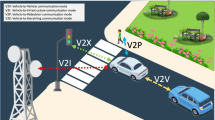Abstract
This article introduces a high-level system using belief functions for exchanging and managing imperfect information about events on the road in vehicular ad hoc networks. The main purpose of this application is to provide the most reliable information for the driver from multiple messages received informing the driver about events on the roads. This system and some variants are tested using a MATLAB™ simulator. An implementation with Android smartphones using a Bluetooth technology to exchange the messages is also introduced.











Similar content being viewed by others
References
Boukerche A (2001) Performance comparison and analysis of ad hoc routing algorithms. In: IEEE international conference on performance, computing and communications, pp 171–178
Bou Farah M, Mercier D, Lefèvre É, Delmotte F (2011) Towards a robust exchange of imperfect information in inter-vehicle ad-hoc networks using belief functions. In: IEEE intelligent vehicles symposium IV’2011. Baden-Baden, Germany, pp 436–441
Cenerario N, Delot T, Ilarri S (2008) Dissemination of information in inter-vehicle ad hoc networks. In: IEEE intelligent vehicles symposium (IV’2008). IEEE Computer Society, Eindhoven (The Netherlands), pp 763–768
Cherfaoui V, Denoeux T, Cherfi ZL (2008) Distributed data fusion: application to confidence management in vehicular networks. In: International conference on information fusion (FUSION’2008). Germany, pp 846–853
Corson S, Macker J (1999) Mobile ad hoc networking (MANET): routing protocol performance issues and evaluation considerations, RFC 2501
Defude B, Delot T, Ilarri S, Zechinelli-Martini J-L, Cenerario N (2008) Data aggregation in VANETs: the VESPA approach, Mobiquitous’08. In: 1st international workshop on computational transportation science (IWCTS). ACM Digital Library, Dublin
Delgrossi L, Zhang T (2012) Vehicle safety communications: protocols, security, and privacy. Wiley, Hoboken
Delot T, Cenerario N, Ilarri S (2008) Estimating the relevance of information in inter-vehicle ad hoc networks. In: International workshop on sensor network technologies for information explosion era (SeNTIE’08). IEEE Computer Society, Beijing, pp 151–158
Delmotte F, Smets P (2004) Target identification based on the transferable belief model interpretation of Dempster-Shafer model. IEEE Trans Syst Man Cybern A 34:457–471
Denœux T (2008) Conjunctive and disjunctive combination of belief functions induced by non distinct bodies of evidence. Artif Intell 172(2–3):234–264
European CAR 2 CAR Communication Consortium (2013) http://www.car-to-car.org. Accessed 21 Nov 2013
Hong X, Xu K, Gerla M (2002) Scalable routing protocols for mobile ad hoc networks. IEEE Netw Mag 16:11–21
Mercier D, Denœux T, Masson M-H (2010) Belief function correction mechanisms. In: Bouchon-Meunier B, et al. (eds) Studies in fuzziness and soft computing, vol 249, pp 203–222
Mercier D, Lefèvre É, Delmotte F (2012) Belief functions contextual discounting and canonical decompositions. Int J Approx Reason 53(2):146–158
Morsink P, Hallouzi R, Dagli I, Cseh C, Schafers L, Nelisse M, Bruin DD (2003) CarTalk 2000: development of a cooperative ADAS based on vehicle-to-vehicle communication. In: World congress and exhibition on intelligent transport systems and services. Madrid, Spain
Nadeem T, Dashtinezhad S, Liao C, Iftode L (2004) TrafficView: traffic data dissemination using car-to-car communication. ACM Mobile Computing and Communications Review (MC2R). Spec Issue Mob Data Manag 8(3):6–19
Reichardt D, Miglietta M, Moretti L, Morsink P, Schulz W (2002) CarTALK 2000: safe and comfortable driving based upon inter-vehicle-communication. IEEE Intell Veh Symp 2:545–550
Ristic B, Smets P (2004) Belief function theory on the continuous space with an application to model based classification. In: International conference on information processing and management of uncertainty in knowledge-based systems IPMU’04, pp 4–9
Royer EM, Toh C-K (1999) A review of current routing protocols for ad hoc mobile wireless networks. IEEE Pers Commun 6(2):46–55
Shafer G (1976) A mathematical theory of evidence. Princeton University Press, Princeton
Smets P, Kennes R (1994) The transferable belief model. Artif Intell 66:191–243
Smets P (1995) The canonical decomposition of a weighted belief. In: International joint conferences on artificial intelligence, pp 1896–1901
Smets P (1998) The transferable belief model for quantified belief representation. In: Gabbay DM, Smets P (eds) Handbook of defeasible reasoning and uncertainty management systems, vol 1. Kluwer Academic, Dordrecht, pp 267–301
Smets P (2005) Decision making in the TBM: the necessity of the pignistic transformation. Int J Approx Reason 38(2):133–147
US Department of Transportation (2013) RITA ITS program. http://www.rita.dot.gov/. Accessed 21 Nov 2013
Acknowledgments
This work has been financed by the French region Nord-Pas de Calais under the project Campus International pour la Sécurité et l’Intermodalité des Transports (CISIT). The authors are very grateful to the VESPA team, in particular Thierry Delot and Sylvain Lecomte from LAMIH Laboratory, University of Valenciennes, for having helped them in their developments. The authors would like to thank the anonymous reviewers for their valuable comments which have helped them to improve the clarity and the quality of this article.
Author information
Authors and Affiliations
Corresponding author
Rights and permissions
About this article
Cite this article
Farah, M.B., Mercier, D., Lefèvre, É. et al. A high-level application using belief functions for exchanging and managing uncertain events on the road in vehicular ad hoc networks. Ann. Telecommun. 69, 185–199 (2014). https://doi.org/10.1007/s12243-013-0410-7
Received:
Accepted:
Published:
Issue Date:
DOI: https://doi.org/10.1007/s12243-013-0410-7




